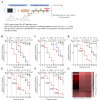Small Molecule Inhibitors of White Spot Syndrome Virus: Promise in Shrimp Seedling Culture
- PMID: 33810591
- PMCID: PMC8036603
- DOI: 10.3390/ijms22073450
Small Molecule Inhibitors of White Spot Syndrome Virus: Promise in Shrimp Seedling Culture
Abstract
Rapid production of prawn (Litopenaeus vannamei) under artificial pressure can result in a series of obvious challenges and is vulnerable to serious losses related to aquatic environmental issues and the unrestrained outbreak of white spot syndrome (WSS). However, to date, there are no therapeutic strategies to contain the spread of the virus. Here, we synthesized 27 coumarin derivatives and evaluated their anti-white spot syndrome virus (WSSV) activity in L. vannamei larvae. We demonstrated that electron-withdrawing and electron-giving substituent groups play an important role in reducing toxicity and WSSV replication, respectively. Two coumarin C2 (2-amino-5-oxo-4-(p-tolyl)-4H,5H-pyrano[3,2-c]chromene-3-carbonitrile) and C7 (2-amino-4-(4-chlorophenyl)-5-oxo-4H,5H-pyrano[3,2-c]chromene-3-carbonitrile) were regarded as the most promising anti-WSSV compounds with maximum antiviral response <5% and median effective concentration <10 mg/L. The mortality of WSSV-infected larvae decreased by more than 60% after exposure to C2 and C7. With continuous immersion of C2 and C7 exchange, the mortality further decreased to 40% at 120 h. Additionally, C2 and C7 are the relatively stable in aquacultural water, making these agents suitable for use in inhibiting WSSV horizontal transmission in static aquaculture systems. These results showed the marked advantages of using C2 and C7 in the shrimp industry, and suggest that they hold potential for the treatment and prevention of WSSV infection in shrimp seedling culture.
Keywords: Litopenaeus vannamei; continuous immersion; coumarin; horizontal transmission; white spot syndrome virus.
Conflict of interest statement
The authors declare no conflict of interest.
Figures









References
-
- Thitamadee S., Prachumwat A., Srisala J., Jaroenlak P., Salachan P.V., Sritunyalucksana K., Flegel T.W., Itsathitphaisarn O. Review of current disease threats for cultivated penaeid shrimp in Asia. Aquaculture. 2016;452:69–87. doi: 10.1016/j.aquaculture.2015.10.028. - DOI
-
- 46th ESAO Congress 3–7 September 2019 Hannover, Germany. [(accessed on 25 March 2021)]; Available online: https://journals.sagepub.com/doi/abs/10.1177/0391398819860985?journalCod.... - DOI
MeSH terms
Substances
Grants and funding
LinkOut - more resources
Full Text Sources
Other Literature Sources
Medical
Research Materials
Miscellaneous

